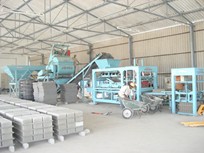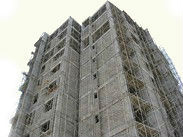The Unique Holistic E4 Technology – Having no Parallel in the World
(Ecology – Environment – Economy – Empowerment)
Eco Carbon Pvt. Ltd., offers a Reward of Rs. 1.00 million to the 1st Contestant who can demonstrate parallel or better technology anywhere in the World complying in a holistic manner with the indicators of Sustainable Development, economic activity and employment potential as good as that of FaL-G.
FaL-G is the name of the product christened to it after its ingredients, Fly ash, Lime and Gypsum.
FaL-G is the Technological Renaissance of cement chemistry, taking clue from the ancient Roman construction technologies. It is the patented invention of Dr N Bhanumathidas and N Kalidas, emerged out of national agenda for promoting fly ash utilisation of over 63 million tons (as in 1990). It is the assimilation of agenda for pollution abatement and protection of ecology. The inventors have promoted a scientific NGO outfit, Institute for Solid Waste Research & Ecological Balance (INSWAREB), in order to catalyse the proliferation of fly ash brick industry, as well as to carry on sustained research for the utilisation of total industrial byproducts.
The product is designed to be practiced in two ways: Lime route and Cement route where, in either case, the pozzolanic reactions are inventively fortified by sulphate chemistry, in order to make FaL-G as the cementitious product for structural and non-structural applications. Manufacturing of bricks and blocks is one of its product avenues.
FaL-G brick and block technology is such a stupendous success in India by the level of its proliferation. About 27,000 plants are working at national level (2021) creating employment to over 405,000 workers, producing bricks and blocks eq. to over 81 billion standard bricks, resulting in the abatement of over 19.44 million tons of CO2. This technology targets to multiply this achievement at least by 4 times for which Clean Development Mechanism is one of the tools to be availed.
In a nut shell, it is the unique technology to serve all the parameters of Sustainable Development which has no parallel even at global level.
To make CDM as a feasible exercise, INSWAREB supported Eco Carbon Pvt Ltd., in signing with The World Bank, offering to transfer 800,000 tons of carbon credits (600,000 as contractual obligation and 200,000 under call option). Under this program over 112 FaL-G brick/block units operated throughout the country have been compiled into four bundles. This project has been successfully accomplished and the contract CERs have been delivered to the World Bank by 2014. In the process, total of six bundles have been registered with CDM; the last one got registered by 2015.
In the light of bleak prices for CERs, it is contemplated to get accreditation of Gold Standard to all the bundles on hand. But due to complexities of the mechanism and exploitations by DOE, the whole program is terminated.
The video-link below gives a comprehensive account of journey through this technology as on May 2012.
Development and Dissemination of FaL-G Technology
How to participate in the FaL-G bundle and earn Carbon Revenue?
Monograph on FaL-G:CDM Project from Min. of Finance and World Bank



